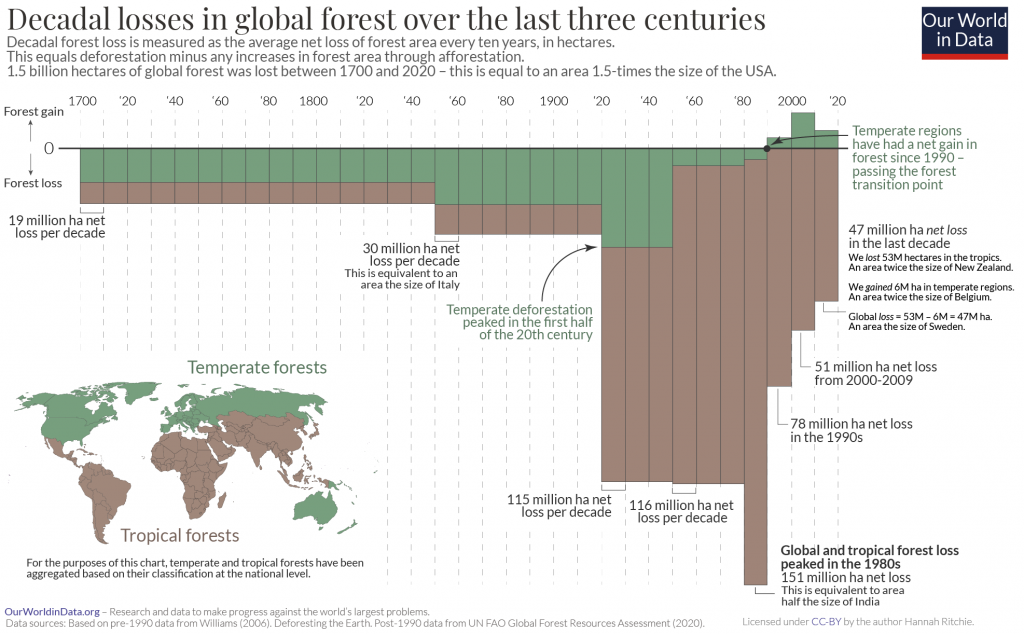How Sustainable Is Bamboo “Wood”? Here Are the Facts
Impactful Ninja is reader-supported. When you buy through links on our site, we may earn an affiliate commission.
Learn more
Learn more
.
Hey fellow impactful ninja ? You may have noticed that Impactful Ninja is all about providing helpful information to make a positive impact on the world and society. And that we love to link back to where we found all the information for each of our posts. Most of these links are informational-based for you to check out their primary sources with one click. But some of these links are so-called "affiliate links" to products that we recommend. First and foremost, because we believe that they add value to you. For example, when we wrote a post about the environmental impact of long showers, we came across an EPA recommendation to use WaterSense showerheads. So we linked to where you can find them. Or, for many of our posts, we also link to our favorite books on that topic so that you can get a much more holistic overview than one single blog post could provide. And when there is an affiliate program for these products, we sign up for it. For example, as Amazon Associates, we earn from qualifying purchases. First, and most importantly, we still only recommend products that we believe add value for you. When you buy something through one of our affiliate links, we may earn a small commission - but at no additional costs to you. And when you buy something through a link that is not an affiliate link, we won’t receive any commission but we’ll still be happy to have helped you. When we find products that we believe add value to you and the seller has an affiliate program, we sign up for it. When you buy something through one of our affiliate links, we may earn a small commission (at no extra costs to you). And at this point in time, all money is reinvested in sharing the most helpful content with you. This includes all operating costs for running this site and the content creation itself. You may have noticed by the way Impactful Ninja is operated that money is not the driving factor behind it. It is a passion project of mine and I love to share helpful information with you to make a positive impact on the world and society. However, it's a project in that I invest a lot of time and also quite some money. Eventually, my dream is to one day turn this passion project into my full-time job and provide even more helpful information. But that's still a long time to go. Stay impactful,Affiliate Disclosure
Why do we add these product links?
What do these affiliate links mean for you?
What do these affiliate links mean for us?
What does this mean for me personally?
Do you know that bamboo is stronger than steel yet super flexible? Its properties make bamboo an ideal material for durable products like furniture, flooring, and other household projects (not to mention earthquake-proof shelters). And when it comes to sustainability, bamboo is on the top of the list. So we had to ask: How sustainable is bamboo wood?
Bamboo is a sustainable alternative to woods in making furniture and other household items. The tree-like grass is fast to grow, easy to process, lasts a long time, and can be fully recycled. On top of that, industrial bamboo products have a small carbon footprint or can even be carbon negative.
This article breaks down the life-cycle of bamboo “wood” used for furniture and other household items. We evaluate its sustainability, potentials, and shortfalls. In the end, we’ll also share tips for buying sustainable bamboo.
Here’s How Sustainable Bamboo “Wood” Is
Bamboo is increasingly used as an alternative to wood in making furniture and many other home products, from floor to ceiling. Besides being strong and naturally resistant to infestation and water, bamboo furniture can be truly sustainable.
“Sustainable: The ability to be maintained at a certain rate or level | Avoidance of the depletion of natural resources in order to maintain an ecological balance”
Oxford Dictionary
To understand the sustainability of bamboo, we assess the life-cycle of products like furniture, flooring, or construction panels. Life-cycle assessment (LCA) is a method to evaluate the environmental impacts of each stage in a product’s life-cycle, from the making to the recycling. Over the years, companies have strategically used LCA to research and create more sustainable products.
In this article, we use the cradle-to-grave perspective of the LCA. However, you will also find some cradle-to-gate data when it’s relevant.
| The life-cycle stages of bamboo (furniture) | Each stage’s sustainability |
| Growing of bamboo | Bamboo growing is a sustainable process as the plant grows very fast and requires no fertilizers. |
| Manufacturing of bamboo | Some methods of manufacturing bamboo furniture are not energy-intensive and involve few chemicals, making it fairly sustainable. |
| Transporting of bamboo | Transporting bamboo can have a relatively small carbon footprint because bamboo is very light, much lighter than any woods. |
| Usage of bamboo | Bamboo furniture can last for a long time because this material is strong and resilient to many environmental factors. The extended period of usage makes this stage a sustainable one. |
| End-of-life of bamboo | The end-of-life stage is sustainable. Some methods of bamboo furniture manufacturing allow the whole furniture to be recycled for energy. And its impact can even mean a carbon-negative footprint for some bamboo products. |
Every stage of bamboo furniture’s life-cycle is sustainable. Bamboo could even “save the world,” as researcher Pablo van der Lugt argued. However, some bamboo products are better for the environment than others. It is important, as for bamboo and other woods, to source the most sustainable option when available.
Let’s take a closer look at this now and dive into each stage and its sustainability.
How Sustainable Is the Growing Bamboo “Wood”
Growing bamboo for “wood” is sustainable because of its quick growth rate, the short time to maturity (compared to wood), and its ability to self propagate.
As bamboo can also grow well in poor, flood-prone soil, it’s an ideal plant for afforestation, replacing forests, and increasing carbon capture quickly.
What Type of Wood is Bamboo and What Does This Mean for Sustainability
Bamboo is technically not wood but a tree-like grass that propagates on its own through rhizomes.
Bamboo reaches maturity within one to five years, depending on the species. When the plant is harvested without disturbing the root, it can regrow at the rate of up to 3 feet (90cm) per day, depending on the variety. That is much faster than the fastest-growing hardwood trees, which only grow around 20 inches (50 cm) per year and take up decades to mature.
How Sustainably Does Bamboo “Wood” Grow
Bamboo can be a very sustainable crop thanks to its rapid growth and self-regeneration without the need for fertilizer, pesticide, and herbicide, as well as its potential for carbon sequestration.
The following section zooms into three sustainable effects of growing bamboo:
- Short duration of growth: After three to five years of planting, mature bamboo can be harvested sustainably. If the roots are left undisturbed, the plant can regrow very quickly without any other inputs but water and sunlight.
- Low CO2 profile: One acre of bamboo can absorb around 10,000 lbs of carbon dioxide per year. Bamboo produces 35% more oxygen than a tree with an equivalent mass. Besides the carbon sequestration of living bamboo, durable products like furniture or floor are carbon storage. They are better for the environment than emissions-intensive materials, including plastics, cement, and metals. Pablo van der Lugt calculated that if bamboo is planted on 350 million ha (around 865 thousand acres) of degraded land by 2030, such new forests will capture ten times worldwide annual CO2 emissions.
- Promotes soil protection: The roots of bamboo create a fibrous network underground, which helps hold the soil together. It protects soil from erosion and minimizes landslides during the frequent monsoons and heavy rain in many growing regions. Bamboo can thrive in locations where it is impossible to plant trees, making it a good crop for reforestation.
- Questionable land usage: One potential problem with the sustainability of bamboo usage in furniture, flooring, and many household items is its land usage. Currently, commercial monocropping bamboo farms are concentrated mostly in China. Monoculture is bad for biodiversity, whether it’s bamboo in China, soy in Brazil, or corn in the US.
While bamboo doesn’t require artificial fertilizers, farmers might use them to increase their crop outputs. Without adequate regulations and information transparency, it is not always straightforward to evaluate the sustainability of your bamboo products.
Where Is Bamboo “Wood” Usually Grown
With more than 1500 species, bamboo can grow in many places, from hot regions in South East Asia, Africa, Australia, Latin America, and southern areas of the US to colder places in the US and the UK.
Two giant bamboo species with huge application potentials are ‘Moso’ bamboo, which grows mainly in China, and ‘Guadua’ bamboo, native to countries in Latin America.
Despite the quick rate of replacement, the degradation of bamboo vegetation does have its implications. When it happens in tropical climates with high biodiversity, the replacement of endangered species such as African mountain gorillas and the giant pandas is a cause of concern.
In total, logging of forestry products from plantations accounts for 26% of forest loss, which is a combination of deforestation and forest degradation. However, the loss in bio-diverse forests in tropical climates is more significant (and sometimes less properly recorded) than in temperate, well-managed logging forests.
How Sustainable Is the Manufacturing of Bamboo “Wood”
Manufacturing bamboo furniture, flooring, and other household items can be sustainable, especially when it uses only organic elements.
Bamboo is a tree-like grass that is stronger than steel. Thanks to dense fibers, bamboo is super flexible and can be bent without snapping. These properties mean that it is possible to make durable bamboo furniture without much (energy-intensive) engineering.
The process to transform bamboo into furniture or flooring can have a relatively low carbon footprint and involve little chemical usage. Typically, the method comprises cutting, stripping, and sanding bamboo culms, boiling, decarbonizing, and drying before assembling the final product.
For an industrial 3-layer laminated bamboo board produced in a factory in China, the manufacturing step accounts for 75% of the product’s CO2 emissions. However, the total CO2 equivalent (carbon footprint, cradle-to-gate) of such a product is only around 2 pounds (~1kg). The number can even be smaller in the cradle-to-grave model, where end-of-life products are burned for bioenergy. For comparison, in a cradle to grave perspective, the carbon footprint of a door made of American oak is 28 kilograms of CO2 equivalent.
It is possible for the manufacturing process of bamboo furniture to be zero-waste. When harvesting, weaker culms can be recycled and used for power in other parts of the manufacturing process or to make non-durable goods. The offcuts, chips, and sawdust can be processed into value-added products like bamboo-based particles or biomass-based energy for cooking, heating, and electricity.
How Sustainable Is the Transportation of Bamboo “Wood”
Transporting bamboo has a relatively small carbon footprint thanks to its being light, non-perishable material. The transportation stage can also be sustainable – at least when buying and selling locally.
In 2018, Asia Pacific accounted for 59% of bamboo furniture consumption. China is the major producer and consumer of these products. However, bamboo furniture made in China has also been shipped to other markets like the US or Europe.
For example, the transportation of industrial bamboo products from China to the Netherlands accounts for around a quarter of the product’s carbon emission (largely due to its being a lightweight “wood”).
There’s validity in the argument that using FSC-certified woods from locally managed forests for your furniture and flooring is a better option than bamboo shipped in from the other side of the world.
However, it is important to stress again that the total emissions of such products are minimal in cradle-to-gate life assessment and potentially negative when including the end-of-life phase.
Where adequate regulations are not in place, bamboo production could be less sustainable than it should have been, such as unnecessary use of chemical fertilizer to boost growth or illegal logging of immature plants. However, some companies and organizations, such as International Network for Bamboo and Rattan, are highly committed to sustainable bamboo.
How Sustainable Is the Usage of Bamboo “Wood”
The usage of bamboo in making furniture, flooring, and other household items is very sustainable thanks to its durability.
Bamboo is more durable than traditional hardwoods. It’s stronger than steel, more resistant to water, infestation, rotting, and warping than hardwood.
Bamboo furniture, such as beds, chairs, tables, or stools, can be used indoors and outdoors for private homes and commercial, public buildings. Outdoor bamboo chairs and tables don’t swell or shrink due to temperature and humidity changes; in general, they last longer than other wooden outdoor furniture.
How Sustainable Is the End-of-Life of Bamboo “Wood”
Because bamboo furniture can be fully recycled or used for bioenergy, the end-of-life for bamboo is also sustainable.
If bamboo furniture and household items are made using knock-down, biological elements – that can be dismantled and recycled – they can be burned as biomass to produce electricity in a power plant.
Together with the carbon sequestration of the live bamboo plants that make these items, the fossil-free energy generation through burning at the end of the product’s life potentially makes these kinds of bamboo products carbon-negative. Industrial bamboo products could be a more sustainable substitute for even sustainably sourced hardwoods.
How Can You Buy Bamboo “Wood” More Sustainably
The key to sustainably buying any wood is to check on relevant environmental and original certifications.
Bamboo is a sustainable crop, especially when it is used for furniture and home building material. However, as it is strictly not a tree but grass, sustainable tree management systems might (arguably) have some shortfalls. Because of the long-distance in the supply chain, for example, when bamboo furniture is made in places like China and used in the US, consumers might find it difficult to find reliable information about managing the forests where bamboo is grown for their furniture.
However, here are the good places to start:
- Forest Stewardship Council: FSC was established with trees in mind, while bamboo is officially a grass. However, bamboo manufacturers (such as this one or this one) can get FSC certification if they follow the ecosystem management standards set by FSC.
As bamboo is naturally more sustainable than wood, there is controversy about the suitability of FSC to bamboo manufacturing, as it causes extra cost and burden for the growing communities.
- Program for Endorsement of Forest Certification: The adoption of PEFC by the China Forest Certification Scheme means that such standards for sustainable forest management reach a broader cover, including bamboo and other non-wood forest products. Chinese bamboo furniture with PEFC certification would come from sustainably managed forests, where bamboo is harvested at the mature time and during the right season, considering other matters like carbon storage and water and fauna.
In addition, you can also find information about sustainable bamboo via WWF and INBAR.
Why Is It Important to Buy More Sustainable Wood
Buying sustainable wood also means helping to prevent illegal or unsustainable logging, which harms the forests’ biosystems and accelerates climate change.
Logging of forestry products from plantations accounts for 26% of forest loss. Cutting down trees for woods has a lesser impact on carbon storage than digging up the whole forest floor and turning it into farms or mines. However, if logging is not sustainably managed, it can badly damage wildlife.
When logging happens in tropical forests – the bio hotspots of our planet – the biodiversity loss can be much more damaging. Subtropical and tropical forests are packed with unique wildlife – endemic mammal, birds and amphibians. The displacement of such wildlife during poorly managed logging would be a major contributor to global biodiversity loss.
Sustainable management of forests also means that trees are cut down for timber only when they are mature. These trees will then be able to regrow and eventually replace the loss of canopy, absorb carbon from the atmosphere and reduce the effect of climate change.
Final Thoughts
Bamboo is an amazing plant, which can give us many sustainable products. It grows and regrows fast, being able to adapt to many corners of our planet. Also, planting bamboo for carbon absorption has a legitimate potential for tackling climate change. So next time you need new furniture or flooring, please do consider the humble bamboo.
Stay impactful,
Sources
- Science Direct: Life-cycle assessment (LCA)
- MIT SMR: Strategic Sustainability Uses of Life-Cycle Analysis
- European Environment Agency: cradle-to-grave
- Science Direct: Cradle-to-Gate Assessment
- Eco And Beyond: Truth or Trend: Is Bamboo Sustainable?
- TOOLS ARCADE: Fastest Growing Timber in the World
- The Guardian: The bear’s necessity
- ECONATION: Bamboo
- Impactful Ninja: 5 Least Sustainable Vegan (Plant-based) Foods
- INTERESTING ENGINEERING: Bamboo as a replacement to steel
- Moso Bamboo: Technical Report
- Research Gate: Carbon Sequestration by Bamboo Farming on Marginal Land and Sustainable Use of Wood Waste for Bioenergy: Case Studies from Abellon Clean Energy
- American Hardwood: Environmental Life-Cycle Assessement
- INBAR: Bamboo in the Circular Economy
- GRAND VIEW RESEARCH: Bamboo Furniture Market Size, Share & Trends Analysis Report By Type (Chairs & Tables, Stools, Beds), By End User (Residential, Commercial), By Region, And Segment Forecasts, 2019 – 2025
- Blooming Sense: Bamboo Bedroom Furniture
- TUDelft: Environmental Assessment of Industrial Bamboo Products
- TED: Bamboo to save the world
- Forest Stewardship Council
- FSC: The Miracle of Bamboo
- Moso-Bamboo: Certification
- Research Gate: The Legitimacy of Bamboo Certification: Unpacking the Controversy and the Implications for a “Treelike” Grass
- Program for Endorsement of Forest Certification
- Our World in Data: Epidemic Mama Species




 ® Fabrics? A Life-Cycle Analysis" itemprop="image" class="left" />
® Fabrics? A Life-Cycle Analysis" itemprop="image" class="left" />


